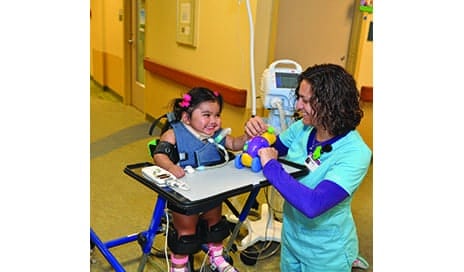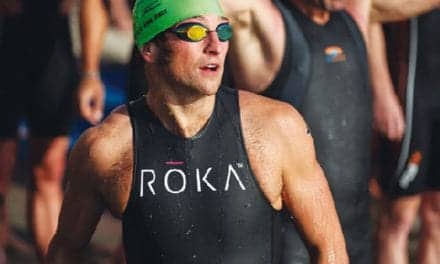
Standing systems built especially for the pediatric population have been updated with features intended to appeal to young users, including a range of frame colors and sizes from extra small to medium. Some models are built to accommodate infant sizes as well.
By Matthew D. Ulmer, PT, DPT
I feel like I’m so tall!” This is an announcement therapists have all heard while a client stands for the first time with a standing system following a spinal cord injury or other neurological condition. As healthcare providers, therapists have a responsibility to educate their patients that being upright is beneficial and can help them re-engage to their environment. Clinicians working to improve upright tolerance, provide long-duration pressure reliefs, long-duration trunk, hip, and knee extension stretching, improved circulation, improved loading of lower extremities, and improved quality of life should determine the most appropriate method of achieving standing.
It is always important to consider the literature regarding potential benefits as therapists prescribe standing devices.
Bone Density
Clinicians are always looking for ways to improve bone health following a neurological condition. Goktepe reported in Journal of Spinal Cord Medicine1 that no significant changes in bone density were seen in lumbar spine and proximal femur scores between three groups of no standing, daily standing less than 1 hour, and daily standing greater than 1 hour. There were slight improvements, however not significant, noted with the group that was standing greater than 1 hour every day. Additionally, Ben reports in the Australian Journal of Physiotherapy2 that patients standing for 30 minutes per day and three times per week had slight improvements in ankle range of motion, but little to no effect on femur bone density. Bone density research results have been inconclusive and vary depending on the protocol and bones studied.
Blood Pressure/Hypotension
A common reason to utilize standing devices is to improve upright tolerance and decrease the debilitating effects of orthostatic hypotension. Chelvarajah3 reports that of the 293 respondents to a questionnaire regarding hypotension and standing frames, 38% suffered from hypotension, 52% reported using standing devices, and 20% reported limiting standing due to hypotension. Of those who did not use standing devices, 5% reported this was because of fear of worsening orthostatic hypotension. It is important for clinicians to provide adequate measures and treatments to allow success with standing devices, including binders, compression, hydration, and medication management. When hypotension is managed properly, clinical observations note that clients who improve with standing tolerance also improve with tolerance to therapeutic activity, functional mobility, and desired daily activities, improving quality of life.
Bowel Programs
In a recent randomized controlled trial published in Spinal Cord,4 Kwok provided research that a regular standing program does not significantly affect the time to first stool component of a bowel program. It is known, however, that many factors can affect the success of time to first stool, including time since the injury, diet, activity levels, and other health considerations. Hoenig5 reports a success story in a single case study. They reported a client who was suffering from constipation and bowel impaction had a significant increase in bowel movements and decrease in bowel care time following 5 days/week standing program. Future studies need to prove what clinicians are seeing clinically in single case studies regarding the impact of standing on other aspects of digestive health.
Wellness
Standing activities can be a part of clients’ overall wellness programs. Ditor6 found that a group of individuals with spinal cord injuries had significant increases in quality of life following a 9-month exercise program, and no significant changes in pain or stress. Those who did not exercise and those who decreased exercise, following the study, reported pain and stress worsened. Adding a standing routine to these programs is logical to promote client wellness. Furthermore, as clients are successfully standing, they will be prepared to participate in the constantly changing landscape of neurological research. Clinicians need to consider that research continues to move toward ways to get patients upright and walking with use of robotics and electrical stimulation devices. A client is in a much better position to utilize these devices when participating in a regular standing routine.

There are many options available for clients to meet their standing goals. Identification of those goals is important in the justification process as therapists seek funding for this equipment.
Psychological/Quality of Life
As noted above, the physiological benefits reported can vary from one study to another. However, it is important to consider the quality of life of the client as therapists prescribe proper equipment. Nordstrom7 reports through a quality of life survey of 284 participants that standing was overall a positive change when performing standing regularly. Also discovered through this survey was that teenagers who were using the standing frame for greater than 60 minutes per day had lower quality of life scores. Clinicians recommend clients stand in longer intervals.
However, a younger client may not enjoy static standing for greater than 60 minutes. Also intriguing to consider, Rhode8 presented a study with nine individuals participating who had received neuroprostheses to allow standing and gait activities with 8-channel electrical stimulation. They reported a significant improvement in quality of life following the use of the neuroprostheses. To this author’s mind, the Rhode study encourages research to continue with electrical stimulation to promote standing and recovery.
Clinical considerations for the benefits of standing extend beyond those shown through randomized controlled research studies. One cannot ignore the testimonies and case studies in which patients have reported improvements with standing. Shields and Dudley-Javorsky9 followed a client for 2 years logging time spent in a commercially available standing power wheelchair. They found that the client met goals for desired minimum dosage of standing per month and chose to stand in several short increments per day averaging 11 minutes per stand and standing an average of 3.86 days per week. The client was very satisfied, and noted improvements with bowel motility, spasticity, and wound health.
There are many options available for clients to meet their standing goals. Identification of those goals is important in the justification process as therapists seek funding for this equipment. Is standing recommended for physiological benefits? Would standing expand the opportunity for employment? Does standing enhance recreation activity? Insurance policies often do not pay for upgrades or mobile standing devices. Therefore, funding may be an obstacle to obtaining the most appropriate standing system.
A number of manufacturers have engineered standing system technologies that enable users to enjoy the physiological and psychological benefits of standing. Their devices are designed for both pediatric and adult users, and aim to promote the safe and effective support of a client in standing.
Pediatric Standing Systems
Devices built especially for the pediatric population have been updated with features intended to appeal to this group of users, including a range of frame colors such as green, purple, and orange. Among the latest pediatric models are standers that expand possible positioning with supine, prone, 90/90 sitting, and full standing option for positioning. The market offers pediatric standing systems built in sizes from extra small to medium with some able to accommodate infant sizes. Additionally, to extend the use of a standing system over the user’s lifetime, some models are built with a modular design that can be upgraded from a manual stander to an assisted manual system or full hydraulically assisted standing system. Likewise, some models are designed to anticipate a change in physical condition that may accompany growth, thereby offering equipment upgrades that may make the purchase of a new frame unnecessary.
Adult Standing Systems
Among the current technologies are features that accommodate different methods to transfer into the devices. Armrests that flip back and knee supports that swing out of the way are examples of two features that can help make the transfer safer and easier. Additionally, to avoid transfers altogether, an open frame design can enable a wheelchair to be moved in close proximity to the standing system and perform the stand directly from the wheelchair. Sliding seats and adjustable sliding backs are among recent features that can help reduce shear associated with moving from one position to another, such as what may occur in moving from sitting to a standing position.
A glider option is a feature developed for active standing systems with the aim of promoting a user’s strength and range of motion. The gliding feature is distinguished by handles that extend up from near the bottom of the stander and can be gripped by the user to be pushed back and forth. The pushing and pulling of the user’s upper extremities creates a reciprocal motion for the user’s lower extremities to increase stretch and range of motion during the gliding activity. Furthermore, mobile options are available to allow the user to turn a wheel with their upper extremities and move around the house while in standing position.

Recent developments include devices designed with a standing option for outdoor recreation and/or outdoor employment. Clients are excited to use these as a means to access places they didn’t think were possible.
Features for Indoors, Outdoors, and Beyond
The current landscape for standing technologies includes one manufacturer that offers four models of wheelchairs: a manual wheelchair with power stand, a manual wheelchair with manual stand, a power wheelchair with power stand with four-wheel drive, and a power wheelchair with power tilt, recline, standing, and elevate functions. Two additional companies provide a power wheelchair available to the market with full power tilt, recline, and standing modes; one of those companies also provides seat elevation.
Among the newer standing mobility devices is one that offers driving capabilities while in a standing position. This device is not a wheelchair. Rather, the client transfers into the device and the product assists the client into the standing position to allow mobility in standing position.
Furthermore, there are outdoor wheelchairs with a standing option available used with outdoor recreation and/or outdoor employment. These chairs are not primary wheelchairs as they rarely can access home environments. Clients are excited to use these as a means to access places they didn’t think were possible.
These are a few of the most popular options used across the country, which are excellent ways to get clients in standing/upright positions. There are potential barriers to prescribing this equipment for use with clients. The risk of overuse syndromes with manual standing wheelchairs and manual push to stand equipment is a concern. Therapists do not want to put a client at risk of injury or long-term deficits because of time spent with a standing system. Rather, therapists must help clients decide whether it is worth the investment. Therapists may need to encourage using an ultralightweight wheelchair for primary mobility use and a manual standing wheelchair only for situations where standing will be necessary. The power standing wheelchairs are convenient. However, they can be expensive and are often not funded. Power mobility devices may create additional barriers to home access and transportation as well.
Once the client has obtained an appropriate device, it is important to set up that person for success to prevent equipment abandonment. All too often therapists hear about clients who have an expensive piece of equipment that is not being used due to a gradual decrease of use, and then develop a fear of undesired symptoms if they were to return to standing. This can be prevented by getting the client’s support systems involved early to ensure comfort with standing routines and promote carryover from inpatient rehabilitation to home use. If the standing device is also their primary mobility device, it is easier for the client to implement standing throughout their day. If it is necessary to transfer into the standing device, therapists must set realistic goals for them to be successful. Studies lead clinicians to believe the longer the clients stand the more benefits are possible. However, beginning with shorter intervals and progressing to longer intervals as the client experiences the benefits can lead to consistent long-term use.
The responsibility as a clinician can be overwhelming as we promote lifelong health and wellness following a neurological condition. Standing is one tool that therapists can use to impact their clients’ health and quality of life. The experience of witnessing a client’s satisfaction as they speak with a friend at eye level is a reminder of the positive and enduring effects the profession can have on those it serves. RM
Matthew D. Ulmer, PT, DPT, received his Doctor of Physical Therapy degree from University of Iowa in 2004. Upon graduation he began working at Madonna Rehabilitation Hospital in Lincoln, Neb, and has been a therapist on the inpatient acute rehabilitation spinal cord injury unit for more than 10 years. For more information, contact [email protected].
References
1. Goktepe AS, Tugcu I, Yilmaz B, Alaca R, Gunduz S. Does standing protect bone density in patients with chronic spinal cord injury? J Spinal Cord Med. 2008;31(2):197-201.
2. Ben M, Harvey L, Denis S, et al. Does 12 weeks of regular standing prevent loss of ankle mobility and bone mineral density in people with recent spinal cord injuries. Aust J Physiother. 2005;51(4):251-256.
3. Chelvarajah R, Knight SL, Craggs MD, Middleton FR. Orthostatic hypotension following spinal cord injury: Impact on the use of standing apparatus. NeuroRehabilitation. 2009;24(3):237-242.
4. Kwok S, Harvey L, Glinsky J, Bowden JL, Coggrave M, Tussler D. Does regular standing improve bowel function in spinal cord injury, a randomized crossover trial. Spinal Cord. 2015;53(1):36-41.
5. Hoenig H, Murphy T, Galbraith J, Zolkewitz M. Case study to evaluate a standing table for managing constipation. SCI Nurs. 2001;18(2):74-77.
6. Ditor DS, Latimer AE, Ginis KA, Arbour KP, McCartney N, Hicks AL. Maintenance of exercise participation in individuals with spinal cord injury: effects on quality of life, stress, and pain. Spinal Cord. 2003;41(8):446-450.
7. Nordström B, Nyberg L, Ekenberg L, Näslund A. The psychosocial impact on standing devices. Disabil Rehabil Assist Technol. 2014;9(4):299-306.
8. Rohde LM, Bonder BR, Triolo RJ. Exploratory study of perceived quality of life with implanted standing neuroprostheses. J Rehabil Res Dev. 2012;49(2):265-278.
9. Shields RK, Dudley-Javorsky S. Monitoring standing wheelchair use after spinal cord injury: a case report. Disabil Rehabil. 2005;27(3):142-146.






